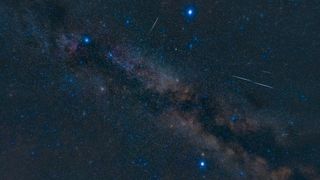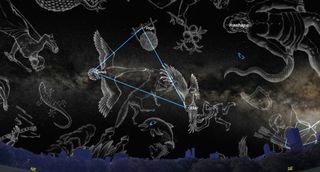See the 'Summer Triangle' in the night sky this month
This annual summer staple will be visible until the end of December.

Look to the sky after dusk to see the bright stars of the Summer Triangle asterism — Vega, Deneb and Altair — rise above the eastern horizon.
The Summer Triangle is an annual feature of the northern summer sky and remains visible until the end of December, according to geophysicist Chris Vaughan, an amateur astronomer with SkySafari Software who oversees Space.com's Night Sky calendar. The star pattern is particularly well placed through July and August as it shines directly overhead at around midnight, according to Science Focus.
If your skies are clear and dark enough, you'll be able to spot the Milky Way galaxy stretching between Vega and Altair through Deneb as the Summer Triangle travels across the night sky, finding itself high in the western sky at the break of dawn.
Related: The brightest planets in July's night sky: How to see them (and when)
The highest and brightest star of the trio is Vega, shining in the Lyra constellation at magnitude 0.03. Vega is located just 25 light-years away from the sun and is relatively easy to spot as it is the brightest star in the summer sky. (On the magnitude scale used by astronomers, lower numbers signify brighter objects. For example, at its brightest, the planet Venus shines with a magnitude of about -4.6.)
Slightly closer, and located in the lower right (southern) corner of the triangle, is Altair, a magnitude 0.75 star in the constellation Aquila. Altair is located 17 just light-years away from the sun.
"By contrast, Deneb, which shines somewhat less brightly at magnitude 1.25, is a staggering 2,600 light-years away from us," writes Vaughan. "But it shines so brightly because of its greater intrinsic luminosity." Deneb is located in the Cygnus constellation.
Get the Space.com Newsletter
Breaking space news, the latest updates on rocket launches, skywatching events and more!

If you're looking for a telescope or binoculars with which to observe the Summer Triangle, our guides for the best binoculars deals and the best telescope deals now can help. Our best cameras for astrophotography and best lenses for astrophotography can also help you prepare to capture the next skywatching sight on your own.

Looking for a telescope for the next stargazing event? We recommend the Celestron Astro Fi 102 as the top pick in our best beginner's telescope guide.
The Summer Triangle is not the only skywatching site to look out for this weekend. Eagle-eyed moon observers will be treated to a lunar show featuring Mare Imbrium's Golden Handle. This surface light effect is produced when low-angled sunlight strikes the Monte Jura mountain range that surrounds Sinus Iridium, the Bay of Rainbows, on the north and west. The "Golden Handle" will be visible on Saturday night (July 9), according to Vaughan.
Editor's Note: If you snap a photo of the Summer Triangle and would like to share it with Space.com's readers, send your photo(s), comments, and your name and location to spacephotos@space.com.
Follow us on Twitter @Spacedotcom and on Facebook.
Join our Space Forums to keep talking space on the latest missions, night sky and more! And if you have a news tip, correction or comment, let us know at: community@space.com.

Daisy Dobrijevic joined Space.com in February 2022 having previously worked for our sister publication All About Space magazine as a staff writer. Before joining us, Daisy completed an editorial internship with the BBC Sky at Night Magazine and worked at the National Space Centre in Leicester, U.K., where she enjoyed communicating space science to the public. In 2021, Daisy completed a PhD in plant physiology and also holds a Master's in Environmental Science, she is currently based in Nottingham, U.K. Daisy is passionate about all things space, with a penchant for solar activity and space weather. She has a strong interest in astrotourism and loves nothing more than a good northern lights chase!
Most Popular


